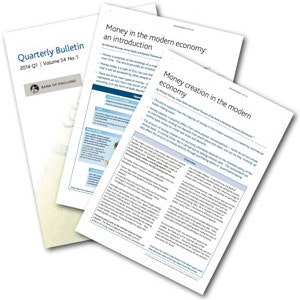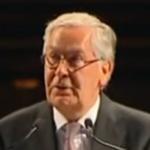How Banks Create Money
Most of the money in our economy is created by banks, in the form of bank deposits – the numbers that appear in your account.

Most of the money in our economy is created by banks, in the form of bank deposits – the numbers that appear in your account. Banks create new money whenever they make loans. 97% of the money in the economy today exists as bank deposits, whilst just 3% is physical cash. This short video explains:
The money that banks create isn’t the paper money that bears the logo of the government-owned Bank of England. It’s the electronic deposit money that flashes up on the screen when you check your balance at an ATM. Right now, this money (bank deposits) makes up over 97% of all the money in the economy. Only 3% of money is still in that old-fashioned form of cash that you can touch.
Banks can create money through the accounting they use when they make loans. The numbers that you see when you check your account balance are just accounting entries in the banks’ computers. These numbers are a ‘liability’ or IOU from your bank to you. But by using your debit card or internet banking, you can spend these IOUs as though they were the same as £10 notes. By creating these electronic IOUs, banks can effectively create a substitute for money.
In the video below Professor Dirk Bezemer at the University of Groningen and Michael Kumhof, an IMF Economist explain where money comes from in less than 2 minutes: Every new loan that a bank makes creates new money. While this is often hard to believe at first, it’s common knowledge to the people that manage the banking system. In March 2014, the Bank of England release a report called “Money Creation in the Modern Economy”, where they stated that:

“Commercial [i.e. high-street] banks create money, in the form of bank deposits, by making new loans. When a bank makes a loan, for example to someone taking out a mortgage to buy a house, it does not typically do so by giving them thousands of pounds worth of banknotes. Instead, it credits their bank account with a bank deposit of the size of the mortgage. At that moment, new money is created.” (Original paper here)
Sir Mervyn King, the Governor of the Bank of England from 2003-2013, recently explained this point to a conference of businesspeople:

“When banks extend loans to their customers, they create money by crediting their customers’ accounts.”
Sir Mervyn King, Governor of the Bank of England 2003-2013 (Speech)
And Martin Wolf, who was a member of the Independent Commission on Banking, put it bluntly, saying in the Financial Times that: “the essence of the contemporary monetary system is the creation of money, out of nothing, by private banks’ often foolish lending” (Article).
By creating money in this way, banks have increased the amount of money in the economy by an average of 11.5% a year over the last 40 years. This has pushed up the prices of houses and priced out an entire generation.
Of course, the flip-side to this creation of money is that with every new loan comes a new debt. This is the source of our mountain of personal debt: not borrowing from someone else’s life savings, but money that was created out of nothing by banks. Eventually the debt burden became too high, resulting in the wave of defaults that triggered the financial crisis.
NEXT: See the Bank of England explain how money is created
Learn More
Overview
The Proof
The way that money is taught in universities is often very inaccurate. These papers and sources from central bankers and other experts show how the system really works.
How We Got Here
The laws that make it illegal for you to print your own £5 or £10 notes have been in place since 1844. But these laws have never been updated to account for the fact that 97% of money is now digital.
How Much Money Have Banks Created?
From the time when the Bank of England was formed in 1694, it took over 300 years for banks to create the first trillion pounds. It took them only 8 years to create the second trillion.
The Technical Details
Video Course: Banking 101
This free animated video course (total 57 minutes) explains how the modern banking system creates money, and what limits how much money banks can create.
Advanced: All the technical details
This section covers all the nitty-gritty details of money creation by banks. We cover the three types of money, how balance sheets work, how central and commercial banks create – and destroy – money and what is wrong about the textbooks taught in universities. Read more…
Books
Book: Where Does Money Come From?
“Refreshing and clear. The way monetary economics and banking is taught in many – maybe most – universities is very misleading and this book helps people explain how the mechanics of the system work.”
– Professor David Miles, Monetary Policy Committee, Bank of England
Book: Modernising Money
Why our monetary system is broken, and how to fix it.
“Money is a social invention, indeed among the most important of all social inventions. At present the right to create money has been handed over to the private businesses we call banks. But this is not the only way we could create money and, as recent experience suggests, it may be far from the best one. Read this book with an open mind and you will understand why.”
– Martin Wolf, Chief Economics Commentator, Financial Times
Further Resources
Papers and videos from:
The Bank of England
The International Monetary Fund
Lord Adair Turner, former chairman of the UK’s Financial Services Authority
Other professors and experts in the monetary system